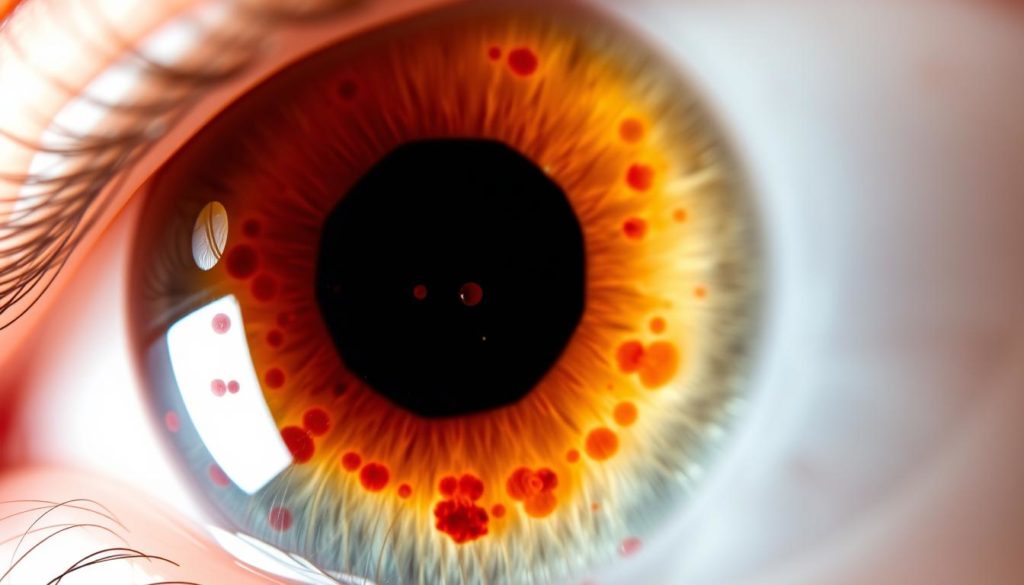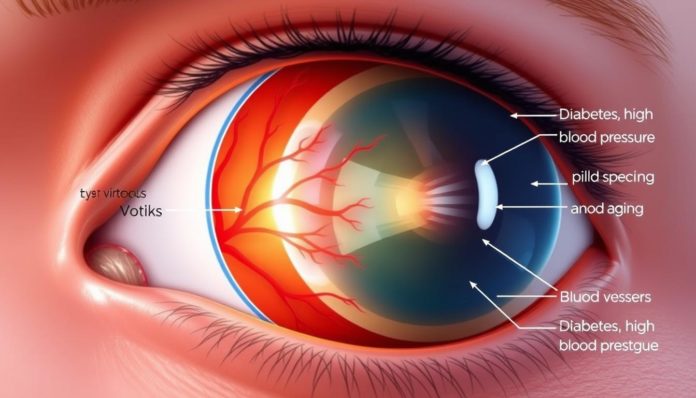Did you know that up to 80% of cases of sudden vision loss are due to vitreous hemorrhage? This is a shocking fact. It shows how crucial it is to know about the risk factors and symptoms of vitreous hemorrhage. It’s a leading cause of eye problems that can really affect your life.
Understanding the risk factors and symptoms of vitreous hemorrhage is key. It helps in catching it early and treating it, which can save your vision. Let’s explore what vitreous hemorrhage is, its common causes, and its symptoms.
What is a Vitreous Hemorrhage?
A vitreous hemorrhage happens when blood leaks into the vitreous humor of the eye. It’s important to know about this condition and how it affects your vision. This knowledge helps you spot symptoms early and get the right treatment.
Definition and Basics
Blood leaking into the eye’s gel-like substance is called a vitreous hemorrhage. This gel, or vitreous body, fills the space between the lens and the retina. When blood clouds this gel, it can blur your vision.
This usually happens due to eye injuries, retinal tears, or health issues like diabetes.
How the Eye is Affected
Blood in the vitreous body can make it hard to see clearly. You might notice floaters, blurry vision, or even temporary blindness. How vitreous hemorrhage affects vision can vary. It might just cause minor problems or serious vision loss that needs quick medical help.

Usually, the blood clears up on its own over time. But, if it doesn’t, or if the problem is severe, you might need medical help. Understanding Vitreous Hemorrhage Explanation and its effects helps you manage it better. It also helps you find the right care.
Common Vitreous Hemorrhage Causes
Vitreous hemorrhage happens for many reasons, affecting your vision and eye health. Knowing why it happens is key to treating and preventing it.

Diabetic Retinopathy
Diabetic retinopathy is a big reason for vitreous hemorrhage. High blood sugar damages the tiny blood vessels in the retina. This can cause bleeding into the vitreous body.
Keeping blood sugar levels in check is crucial. This can help prevent diabetic retinopathy and vitreous hemorrhage. Managing diabetes through diet, medication, and lifestyle changes is important.
Trauma to the Eye
Eye trauma is another common cause of vitreous hemorrhage. It can range from minor accidents to serious injuries. Blunt force, penetrating injuries, or surgery can damage blood vessels inside the eye.
Wearing protective eyewear and following safety rules can help. This is especially important in sports and workplaces where eye injuries are more likely.
Symptoms of Vitreous Hemorrhage
Spotting the signs of vitreous hemorrhage early is key. It helps in managing and treating this eye issue. People often see certain visual changes that hint at this problem.
Floaters in Vision
Vision floaters are a common sign of vitreous hemorrhage. They look like tiny, dark shapes moving in your sight. These can be seen as spots, threads, or even like cobwebs.
Seeing these floaters suddenly can be very scary. It’s a sign that something is wrong with your eyes.
Blurred Vision
Another big symptom is blurred vision. This happens when blood blocks your clear view. It makes everything look fuzzy or unclear.
Blurred vision can happen suddenly. It might affect one or both eyes. If your vision changes quickly, see an eye doctor right away. They can help figure out what’s wrong and treat it.
Vitreous Hemorrhage Explanation
Understanding vitreous hemorrhage means looking closely at this condition. The vitreous humor is a clear gel in the eye. It helps the eye keep its shape and lets light reach the retina. But, when it bleeds, it messes with these important jobs.
When blood vessels in the retina burst, blood spills into the vitreous humor. This makes the eye cloudy, causing floaters, blurry vision, and sometimes total blindness in one eye. The body tries to soak up the blood, but sometimes it needs help.
Managing vitreous hemorrhage involves different treatments. Knowing about it helps doctors choose the right treatment. Here are some important points:
- Self-Clearing: Minor cases might clear up as the body absorbs the blood.
- Medications: Some drugs can help the body absorb the blood faster and reduce swelling.
- Vitrectomy: If the blood doesn’t go away, surgery might be needed. It removes the blood and puts in a clear solution.
Knowing these details helps manage vitreous hemorrhage better. It helps patients get their vision back and keep their eyes healthy.
Diagnosing Vitreous Hemorrhage
Diagnosing vitreous hemorrhage is key for effective treatment. It involves a detailed eye examination and advanced imaging. These steps help find the cause and extent of the hemorrhage.
Ophthalmologic Examination
A thorough eye examination starts the diagnosis. An ophthalmologist checks visual acuity and pupil reactions. They also study the fundus with an ophthalmoscope.
Imaging Techniques
After the eye examination, imaging is crucial. B-scan ultrasonography and optical coherence tomography (OCT) are used. These methods give detailed views of the vitreous cavity and retina.
They help identify different types of hemorrhages and potential retinal detachments.
| Diagnostic Method | Description |
|---|---|
| Ophthalmologic Examination | Assessment of visual acuity, pupil reactions, and fundus using an ophthalmoscope. |
| B-scan Ultrasonography | Provides cross-sectional images of the eye to identify retinal detachments or tumors. |
| Optical Coherence Tomography (OCT) | Offers high-resolution images of the retina to detect structural issues and subtle changes. |
Vitreous Hemorrhage Treatment Options
Treating a vitreous hemorrhage can involve medicine or surgery, depending on how bad it is. It’s key to know the different ways to treat it to choose the right one.
Medical Interventions
Doctors often use medicines to help the eye heal. These medicines can reduce swelling and help the blood in the eye to clear up. They might give you corticosteroids or anti-VEGF shots to help with symptoms.
It’s also important to keep an eye on how you’re doing. This helps make sure the bleeding stops without any problems.
Surgical Procedures
For serious cases, surgery might be needed. A vitrectomy is a surgery where they take out the blood and gel in the eye. This helps clear your view.
Laser therapy is another surgery option. It uses laser burns to stop blood vessels from bleeding more. This helps keep the retina stable and stops it from detaching.
| Treatment Option | Procedure | Indication |
|---|---|---|
| Vitrectomy | Removal of vitreous gel and blood | Severe hemorrhage or persistent bleeding |
| Laser Therapy | Laser burns to seal blood vessels | Retinal stabilization and preventing further bleeding |
Managing Vitreous Hemorrhage
Managing vitreous hemorrhage needs both quick medical help and long-term lifestyle changes. These steps help in recovering vision and keeping eyes healthy. It’s important to take care of your eyes well to avoid more problems.
First, getting quick medical help is key. Ophthalmologists give medicines to fight inflammation and watch the bleeding. Sometimes, a surgery like a vitrectomy is needed to clear the blood and fix vision.
But managing vitreous hemorrhage is more than just quick fixes. Patients need to keep up with long-term care to help their eyes heal and stay healthy. This includes:
- Going to see an ophthalmologist regularly to check on your eyes.
- Eating a healthy diet full of vitamins and antioxidants to help your eyes.
- Controlling health issues like diabetes or high blood pressure to protect your eyes.
- Wearing protective eyewear to avoid eye injuries.
Here’s a look at the quick treatments and ongoing care for eye health:
| Treatment/Strategy | Purpose | Duration |
|---|---|---|
| Medication | Reduce inflammation | Short-term |
| Vitrectomy | Remove vitreous blood | One-time procedure |
| Dietary Adjustments | Improve overall eye health | Long-term |
| Monitoring Underlying Conditions | Prevent recurrence | Ongoing |
| Protective Eyewear | Prevent trauma | Situational |
By focusing on both quick treatments and long-term care, you can manage vitreous hemorrhage better. This approach helps keep your eyes healthy for a long time.
Prevention of Vitreous Hemorrhage
Preventive measures can greatly reduce the risk of vitreous hemorrhage. By taking proactive steps and keeping your eyes healthy, you can lower your risk of vision problems.
Healthy Lifestyle Choices
Leading a healthy lifestyle is key to preventing vitreous hemorrhage. Here are some ways to do that:
- Control Blood Sugar: For diabetic patients, keeping blood sugar levels in check is essential for eye health maintenance.
- Quit Smoking: Smoking can negatively affect blood vessels, leading to increased risk of eye diseases.
- Balanced Diet: Eating a diet rich in vitamins and minerals supports overall eye health. Foods like leafy greens, fish, and fruits are beneficial.
- Regular Exercise: Exercise improves circulation, which can help in maintaining healthy blood vessels in the eyes.
Regular Eye Checkups
Regular eye checkups are vital for monitoring eye health. They help in early detection and prevention of complications. Routine eye exams are crucial for those at higher risk, such as individuals with diabetes or a history of eye trauma.
- Annual Exams: Schedule annual eye examinations to catch any early signs of vitreous hemorrhage.
- Prompt Attention: Visit an eye care professional immediately if experiencing any vision changes or symptoms like floaters and blurred vision.
Merging healthy lifestyle choices with regular eye checkups forms a robust approach for vitreous hemorrhage prevention and effective eye health maintenance.
Prognosis of Vitreous Hemorrhage
The outcome of vitreous hemorrhage depends on several factors. These include the cause, how much blood is lost, and how quickly treatment is given. Early treatment and care are key to better vision after a hemorrhage. Many patients see good results, especially if the bleeding is mild and they get help fast.
Research shows that 75% of people with mild hemorrhages can see better in weeks to months. This highlights the need for regular eye checks and quick action when problems arise. Good blood sugar control can also help those with diabetic retinopathy-related hemorrhages.
But, severe or repeated hemorrhages have a tougher outlook. Surgery, like vitrectomy, might be needed to avoid lasting vision loss. Success depends on the patient’s health and other eye issues. The best chance for recovery comes from following doctor’s orders and keeping up with eye exams.
FAQ
What are the risk factors for vitreous hemorrhage?
Risk factors include diabetes, age-related macular degeneration, previous eye surgeries, and trauma to the eye.
What are the common symptoms of vitreous hemorrhage?
Symptoms include vision floaters, blurred vision, and sudden vision loss. The severity varies with the extent of the hemorrhage.
Can you explain what a vitreous hemorrhage is?
It’s when blood leaks into the vitreous humor. This is the clear gel in the eye. It can impair vision and needs medical attention.
How does a vitreous hemorrhage affect vision?
It clouds the vitreous humor. This can cause blurry vision, spots, shadows, or complete vision loss if severe.
What are some of the common causes of vitreous hemorrhage?
Causes include diabetic retinopathy and eye trauma. Other causes are retinal tears and age-related conditions.
How is vitreous hemorrhage diagnosed?
It’s diagnosed with a detailed eye exam and imaging like ultrasound or optical coherence tomography.
What treatment options are available for vitreous hemorrhage?
Treatments include anti-inflammatory medications and surgical procedures like vitrectomy. This involves removing the vitreous humor and replacing it with saline.
How can vitreous hemorrhage be managed?
Management includes regular eye specialist visits, managing diabetes, and sometimes surgery to remove the hemorrhage or repair retinal damage.
Are there ways to prevent vitreous hemorrhage?
Prevention includes a healthy lifestyle, controlling blood sugar, protecting your eyes, and regular eye checkups.
What is the prognosis for someone with vitreous hemorrhage?
The prognosis varies. Many recover fully with treatment. It depends on the severity, treatment timing, and underlying conditions. Regular monitoring is key.


